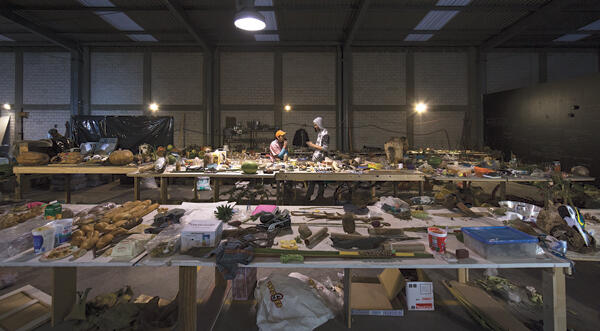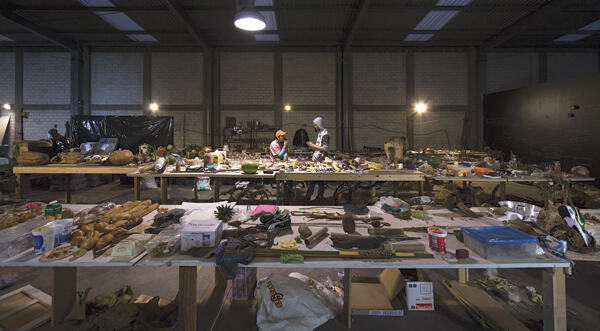Adrián Villar Rojas
Kurimanzutto, Mexico City
Adding color and moving away from monumental sculpture cast in unfired clay, Villar Rojas’ latest in-situ exhibition, Los Teatros de Saturno, at Kurimanzutto gallery does indeed represent a departure from his previous work, though brought to life with the central threads of his creative career, the ephemeral quest for life that often emerges from decay and his theatrical approach to artistic production, well intact.

In a nod to his recent exhibition Today We Reboot the Planet at the Serpentine Sackler Gallery in London, where the artist covered the floor space with bricks brought from his native Argentina, Villar Rojas buried the floor of Kurimanzutto’s central gallery space with pale, loose earth, forcing viewers to make direct contact with the artist’s intervention on the space, coincidentally transforming the piece through interaction and blurring the lines between art object, observer and environment, a theme that runs throughout Villar Rojas’ previous work.
However, unlike the life-size elephant sculpture presented at the Serpentine Sackler or the iconic whale in My Dead Family, created for the End of the World Biennial in 2009, both monumentally three dimensional, the artist opted this time to generate a more two-dimensional installation, with groupings of small sculpture-objects spaced at intervals atop the earthen floor, none more than 30 cm off the ground.
It can be noted that for the first time in the young artist’s career, we see bright colors emerging from what has been a muted palette of grays and beiges. The first room is dotted with pumpkins and watermelons, all slowly rotting. Several are partially opened, and seeds have been planted in the gaping holes of a few with shoots and tiny plant life emerging from moldy craters in the face of the decaying fruit. Other objects, both organic and inorganic, are nestled in places – a tiny bird’s egg, half of a tennis shoe – creating a menagerie of mini-sculptures, each emerging from Villar Rojas theatrical production style.
According to the gallery, the artist considers himself a sort of director to his troupe of creative assistants. The title of the project lends itself to this notion and emerges from studying experimental theater groups in Argentina to see how the model can be transported to artistic production.
The second, larger chamber in fact can be read much like the script of a play. Groupings of sculpture-objects are made into small lines that form patterns on the floor. With many visitors present, people resemble ants forming strange lines in an attempt to navigate the spaces between the sculptures, sensing there must be a correct route, but in reality wandering in a maze, pausing occasionally to consider whether they may step over objects in their way.
Again, life springs from many sources from within the objects with sculptures sprouting mushrooms and green shoots. Maintaining an ever-changing landscape, a member of the troupe comes regularly to water the sculptures, occasionally dropping in a new seed or two.
In both spaces, all objects have various levels of permanence. Fruit will quickly decay, shoes will fall apart, and geometrical objects cast roughly in plaster will eventually crumble and disappear. And life springs eternal. The work instills a sense of nostalgia. That all life and everything experienced within that life will eventually transform until there is nothing left of the original but memory.
-
 On site installation at kurimanzutto, Mexico city /Instalación in situ en la galería kurimanzutto, Ciudad de México. Courtesy of the artista and kurimanzutto Gallery /
On site installation at kurimanzutto, Mexico city /Instalación in situ en la galería kurimanzutto, Ciudad de México. Courtesy of the artista and kurimanzutto Gallery /
Cortesía del artista y kurimanzutto. Photograph / Fotografía Michel Zabé




